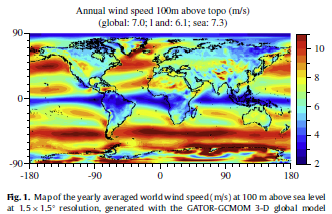Introduction
There is an urgent need for dependable, efficient, and low-cost energy to alleviate problems of energy insecurity as well as environmental pollution. For example, Jacobson and Masters (2001) proposed that the U.S. could meet its Kyoto Protocol obligations for decreasing carbon dioxide discharges by substituting 60% of its coal production plants with wind energy turbines to supplement the country’s energy requirements (p.1438).
Fthenakis, Mason, and Zweibel (2009) also examined the economical, geographical and technical viability of solar power to supplement the energy requirements of the U.S. and concluded that it was possible to substitute the current fossil fuel energy infrastructure with solar energy in order to decrease carbon emissions to internationally accepted levels (p.397).
There is no doubt that efforts to adopt renewable, effective and low-cost energy options have attracted global attention. Consequently, this paper will compare two forms renewable energy (wind and solar energy) in terms of cost, efficiency, energy produced, resources needed, environmental impact and maintenance.
Wind Turbine Energy Technology
Wind turbines usually convert wind energy into electricity. Generally, a gearbox rotates the turbine rotor into fast-rotating gears that eventually transform mechanical energy into electricity in a generator. Although a number of current turbines are gearless and less proficient, they are nonetheless useful when installed in buildings or residential homes (Jacobson & Delucchi, 2011, p.1157).
Solar Energy Technology
Solar photo-voltaics (PVs) refers to groups of cells with silicon materials that transform solar radiation into electricity. As of now, solar PVs are utilized in several different applications, ranging from residential home power generation to medium-scale use. On the other hand, concentrated solar power (CSP) systems utilize reflective lenses or mirrors to focus sunbeams on a liquid to warm it to a high temperature.
The heated liquid runs from the collector to a heat engine in which a part of the heat is transformed into electricity. There are various forms of CSP systems that permit the heat to be stocked up for several hours to facilitate production of electricity at night (Jacobson & Delucchi, 2011, p.1157).
Cost, Efficiency and Energy Produced via Wind and Solar Technology
Figure 1 provides the projected amount of power available globally from renewable energy with respect to raw resources available in high-energy regions. It is worth mentioning that these resources can plausibly be mined in the near future given the location as well as the low extraction costs involved.
Figure 1: Power Available in Energy Resources Worldwide If the Energy is Used in Conversion Devices, in Locations Where the Energy Resource is High, in Likely-Developable Locations, and in Delivered Electricity (For Wind and Solar Energy)
Source: Jacobson & Delucchi (2011).
Figure 1 demonstrates that only wind and solar energy can provide adequate power to meet global energy demands. For example, wind in developable regions can satisfy global energy demands up to about 4 times over while areas with solar energy potential can meet global demands by over 18 times over (Jacobson & Delucchi, 2011, p.1159). Figure 2 illustrates a model of wind resources at 100m in the hub height range of wind turbines.

The global wind energy potential (available over the world’s ocean surface and land at 100m assuming that all wind at speeds is utilized to power wind turbines) has been estimated at 1700 TW. About half of this wind energy (1700 TW) is found in areas that can be extracted feasibly and efficiently (Jacobson & Delucchi, 2011, p.1159).
Resources Required for Wind and Solar Systems
Jacobson and Delucchi (2011) estimate that both solar and wind make up 90% of the future energy supply on the basis of their relative availability (p.1160). Solar PV is split into 70% power-plant and 30% rooftop on the basis of an assessment of the expected available rooftop area.
Rooftop PV has three main benefits: it does not need new land surface; it can be incorporated into a hybrid solar infrastructure that generates electricity, light, and heat for onsite use; and it neither requires an electricity transmission nor distribution infrastructure. The authors suggest that approximately 90,000 solar power plants and about 4 million wind turbines are required to satisfy global energy demands (Jacobson & Delucchi, 2011, p.1160).
The material required for wind turbine energy includes carbon-filament reinforced plastic (for rotor blades); glass-fiber reinforced plastic (for rotor blades); wood epoxy (rotor blades); aluminum (for nacelles); magnetic materials (for gearboxes); pre-stressed concrete (for towers); and steel materials (for rotors, nacelles, towers, etc).
It is worth mentioning that most of these resources are available in abundance supply. For instance, the main components of concrete (i.e. limestone, sand, and gravel) are extensively available at lower costs and can be re-used (Jacobson & Delucchi, 2011, p.1161). On the other hand, the required resources for solar PVs include copper indium sulfide/selenide; cadmium telluride; micro-crystalline silicon; polycrystalline silicon; and amorphous silicon.
Nonetheless, it is important to note that the power generated via silicon PV technologies is constrained by the limited availability of silver materials which are utilized as electrodes (Jacobson & Delucchi, 2011, p.1162). Nevertheless, given that most of resources required for the installation of renewable energy plants are in abundance supply, both wind and solar energy technologies provide low-cost, environmental-friendly and efficient energy options to meet global demand.
References
Fthenakis, V., Mason, J., & Zweibel, K. (2009). The technical, geographical, and economic feasibility of solar energy to supply the energy needs of the US. Energy Policy, 37, 387–399.
Jacobson, M., & Delucchi, M. (2011). Providing all global energy with wind, water, and solar, Part I: Technologies, energy resources, quantities and areas of infrastructures, and materials. Energy Policy, 39, 1154-1169.
Jacobson, M., & Masters, G. (2001). Exploiting wind versus coal. Science, 293, 1438.